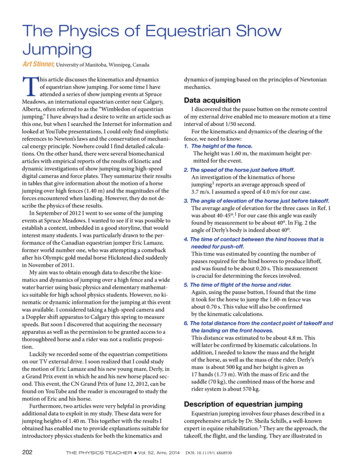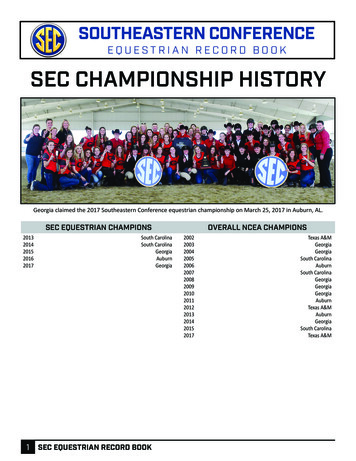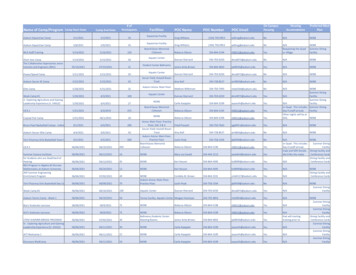
Transcription
The Physics of Equestrian ShowJumpingArt Stinner, University of Manitoba, Winnipeg, CanadaThis article discusses the kinematics and dynamicsof equestrian show jumping. For some time I haveattended a series of show jumping events at SpruceMeadows, an international equestrian center near Calgary,Alberta, often referred to as the “Wimbledon of equestrianjumping.” I have always had a desire to write an article such asthis one, but when I searched the Internet for information andlooked at YouTube presentations, I could only find simplisticreferences to Newton’s laws and the conservation of mechanical energy principle. Nowhere could I find detailed calculations. On the other hand, there were several biomechanicalarticles with empirical reports of the results of kinetic anddynamic investigations of show jumping using high-speeddigital cameras and force plates. They summarize their resultsin tables that give information about the motion of a horsejumping over high fences (1.40 m) and the magnitudes of theforces encountered when landing. However, they do not describe the physics of these results.In September of 2012 I went to see some of the jumpingevents at Spruce Meadows. I wanted to see if it was possible toestablish a context, imbedded in a good storyline, that wouldinterest many students. I was particularly drawn to the performance of the Canadian equestrian jumper Eric Lamaze,former world number one, who was attempting a comebackafter his Olympic gold medal horse Hickstead died suddenlyin November of 2011.My aim was to obtain enough data to describe the kinematics and dynamics of jumping over a high fence and a widewater barrier using basic physics and elementary mathematics suitable for high school physics students. However, no kinematic or dynamic information for the jumping at this eventwas available. I considered taking a high-speed camera anda Doppler shift apparatus to Calgary this spring to measurespeeds. But soon I discovered that acquiring the necessaryapparatus as well as the permission to be granted access to athoroughbred horse and a rider was not a realistic proposition.Luckily we recorded some of the equestrian competitionson our TV external drive. I soon realized that I could studythe motion of Eric Lamaze and his new young mare, Derly, ina Grand Prix event in which he and his new horse placed second. This event, the CN Grand Prix of June 12, 2012, can befound on YouTube and the reader is encouraged to study themotion of Eric and his horse.Furthermore, two articles were very helpful in providingadditional data to exploit in my study. These data were forjumping heights of 1.40 m. This together with the results Iobtained has enabled me to provide explanations suitable forintroductory physics students for both the kinematics and202The Physics Teacher Vol. 52, April 2014dynamics of jumping based on the principles of Newtonianmechanics.Data acquisitionI discovered that the pause button on the remote controlof my external drive enabled me to measure motion at a timeinterval of about 1/50 second.For the kinematics and dynamics of the clearing of thefence, we need to know:1. The height of the fence.The height was 1.60 m, the maximum height permitted for the event.2. The speed of the horse just before liftoff.An investigation of the kinematics of horsejumping1 reports an average approach speed of3.7 m/s. I assumed a speed of 4.0 m/s for our case.3. The angle of elevation of the horse just before takeoff.The average angle of elevation for the three cases in Ref. 1was about 40-45o.1 For our case this angle was easilyfound by measurement to be about 40 o. In Fig. 2 theangle of Derly’s body is indeed about 40o.4. The time of contact between the hind hooves that isneeded for push-off.This time was estimated by counting the number ofpauses required for the hind hooves to produce liftoff,and was found to be about 0.20 s. This measurementis crucial for determining the forces involved.5. The time of flight of the horse and rider.Again, using the pause button, I found that the timeit took for the horse to jump the 1.60-m fence wasabout 0.70 s. This value will also be confirmedby the kinematic calculations.6. The total distance from the contact point of takeoff andthe landing on the front hooves.This distance was estimated to be about 4.8 m. Thiswill later be confirmed by kinematic calculations. Inaddition, I needed to know the mass and the heightof the horse, as well as the mass of the rider. Derly’smass is about 500 kg and her height is given as17 hands (1.73 m). With the mass of Eric and thesaddle (70 kg), the combined mass of the horse andrider system is about 570 kg.Description of equestrian jumpingEquestrian jumping involves four phases described in acomprehensive article by Dr. Sheila Schills, a well-knownexpert in equine rehabilitation.3 They are the approach, thetakeoff, the flight, and the landing. They are illustrated inDOI: 10.1119/1.4868930
Fig. 1. Part 1. The approach and the takeoff.Fig. 1. Part 2. The flight and the landing.Fig. 1 as a sequence of seven sketches labeled (a) through (g).Approach is illustrated in (a) and (b), takeoff in (c) and (d),flight in (e), and landing in (f) and (g). They can be summarized as follows:ApproachThe horse must get to the fence at an even and steady gait(usually a canter motion) so that she can concentrate onthe best spot to take off for the jump. (See Fig. 1.) The horsereaches forward and down with her neck to lower the frontlegs and her CM (center of mass).The front legs are proppedor strutted out in front of the body. This relatively suddenbraking action allows momentum to carry the hind legs further under the body of the horse than would be otherwisepossible.TakeoffAs the horse finishes the last complete stride before thejump, she will begin to shift the weight backward by raising the head, shortening the neck, and lifting the shoulders.The horse’s neck continues to shorten to assist in moving theweight backward. This shortening of the neck also helps toFig. 2. Eric Lamaze and Derly jumping a 1.60-m fence. Thetakeoff angle is almost exactly 40o from the horizontal andthe distance from the fence to the hooves about 2.4 m. Thecenter of mass of the pair is indicated by the blue dot onthe horse. (Photo courtesy of Franz Venhaus)abort the normal forward movement of thecanter. As the weight moves backward, thehind legs compress or coil. With the maximum amount of flexion in the hind joints,the horse can then create the maximumpush against the ground to propel her upand forward over the jump. The horse canhave the most effective takeoff when thehip joint is placed vertically above the hoof.FlightThe hind legs reach maximum extension after they leave theground and the front legs are curled tightest against the body.The knees lift and bend to curl the legs up, the tighter thebetter, so the chance of hitting the fence by the front legs isreduced. To bend the knees and lift the forehand, the scapula(shoulder) rotates upward and forward. During the flight theCM follows an approximate parabolic trajectory.LandingTo slow the forward momentum so that the force of impactis reduced, the horse will swing the neck and head up as theforelegs reach toward the ground. The non-leading front leglands first. When the leading front leg lands, both legs pushagainst the ground in a downward and backward direction.The hindquarters rotate underneath the trunk and reachtoward the ground as the forehand moves forward and out ofthe way of the hindquarters.Analysis of jumpingEquestrian jumping involves clearing hurdles (and waterbarriers) as the beautiful photograph shown in Fig. 2 of Derlyand Eric Lamaze illustrate. It can be likened to hurdle jumping and the long jump of human athletics. Accordingly, theyare analyzed sequentially: first the high fence followed by thewater barrier jump.High fence jumpThe particular jump we choose for analysis here is one of the1.60-m fences that was used in the Grand Prix event at SpruceMeadows. Derly approached this high fence with a speed ofabout 6.0 m/s. The speed was reduced by a shorter stride toabout 4.0 m/s just before anchoring the hind legs in position. We assume that the horizontal speed of 4.0 m/s does notchange significantly during the 0.20-s push-off period.The front legs were lifted and the hind legs stopped moving for about 0.20 s during what is called a “stance phase.”The front legs are coiled so that the body of the horse withreference to the horizontal can be as high as 45o, just beforepush-off. The hind legs uncoil, and at the point of leaving theground, the angle for the trajectory now is about 40o. Duringthis stance phase, the CM of the horse-rider system movesabout 0.80 m (4.030.20).The CM of Derly at the moment of takeoff is estimated tobe about 20 cm along the line of Derly’s body, in front of Eric’sThe Physics Teacher Vol. 52, April 2014203
Parabolavy 3.4 m/sso the height reached by CM isvx 4.0 m/sh (3.4)2 /20 0.58 m.V 5.2 m/s5.2 m/s40oHeight 0.58 mVx 4.0 m/sxxxxxxxxxxxxxxxxxxxxxxxxxxxxxxxxxxxxxxxxxxRange 2.8 mTime of flight 0.68 sFig. 3. The motion of the CM of horse and rider over the 1.60-mfence.The total height from the ground to the center of gravity, assuming the initial CM is approximately the same as the fenceheight, is 1.60 0.58 2.18 m.The horizontal range of the CM is given byRCM 2vx t.(4)Thus RCM 4.030.7 2.8 m. The tangential velocity v at thepoint of liftoff isv (vx2 vy2 )1/2.(5)Thus v (4.02 3.42 )1/2 5.2 m/s.Fig. 4. The kinematics of jumping a 1.60-m fence is representedin this example of an ideal jump. Red arrows indicate launchingpoint and landing point of hooves and the CM motion is given bythe blue arc.right foot. This was done by scaling, that is by comparing distances to the height of the 1.60 bar, using the photo of Eric Lamaze and Derly shown in Fig. 2. Knowing the angle at takeoffand the horizontal velocity, we can easily determine the instantaneous vertical velocity at the beginning, the height, therange, and time of flight for the trajectory.The kinematics of the jumpDerly pushes off when the angle to the horizontal is about40o and the horse-rider system’s CM at this moment happensto be at about the same height as that of the fence. The horizontal velocity is constant at about 4.0 m/s. Where relevant incalculations, it is appropriate (given the 5% accuracy we areworking with) to take g, the acceleration of gravity, to be 10m/s2. The vertical velocity at the moment of liftoff is relatedto the horizontal speed componentvy vx tan 40o.(1)Therefore vy 4.0 tan 40o 3.4 m/s and the time t to reachheight h is obtained fromorvy gt(2)t vy /g 3.4/10 0.34 s.The total time for the trajectory is 2t, i.e., 0.7 s as expected.Applying the equation of uniformly accelerated motion in thevertical direction, we havevy2 2 gh,204(3)The Physics Teacher Vol. 52, April 2014Remember that the horizontal distance from the spotwhere the hind leg hooves take off to the CM, that is, the startof the trajectory, is about 1 m. If the jump is perfectly symmetrical (and it seldom is), the total range R is given by: R 2.8 2.0 4.8 m.It should be noted that the location of the CM of Derlydoes change somewhat during the flight because the horse’sbody configuration changes due to the movement of the neckand the leg during the flight. Therefore, the trajectory is onlyan approximate parabola, as indicated in Fig. 4.The dynamics of the jumpThe motion during the push-off stage that takes about0.20 s is fairly complicated. However, the sketches of Fig. 1suggest that the direction of the force produced by the hindlegs varies by only a small angle (say 15o) about the vertical.However, its line of action is behind the CM by a distance d,which advances significantly during this short time of contact. At the start of the push, Derly’s body is at an elevationangle of about 45o [see Figs. 1(c) and 1(d)]. As the hind legsare pushing forward (remember the hooves are stationaryduring this brief period), the body moves about 0.80 m(4.0 m/s30.20 s) forward. The product d3F, variable in itselfduring the push-off duration of 0.20 s, is a torque that causesDerly to rotate clockwise after the initial counterclockwisemotion produced by the forelegs push-off prior to the jump.When the hooves leave the ground, the CM has moved about0.80 m horizontally and Derly is moving with an initial vertical velocity component of 3.4 m/s and a constant horizontalvelocity component of 4.0 m/s, essentially along a parabolictrajectory. When contact with the ground has ended, thedirection of the body of the horse is about 40o with the horizontal.We assume that for the liftoff most of the force acts in thevertical direction and ignore the horizontal force. The average thrust force during the 0.20-s push-off period can be obtained by using the relationship between impulse and change
of momentum:F Δt m Δv.(6)ThereforeF m Δv/Δt.(7)The total vertical force Fy acting during the impulsive actionto propel the CM of the horse to the elevation h is:Fy mg m Δv/Δt(8)Δv/Δt 3.4/0.20 17 m/s2.Therefore Fy m(g Δv/Δt) 570(10 17) 15,400 N 15.4 kN.This is a large average force that acts during the 0.20-scontact. The force varies during this short time of 0.20 s andreaches a peak of perhaps 19 kN, at about 0.10 s. Therefore,each leg must be able to support a force of about 7700 N in asymmetric case. The total energy supplied by the hind legs forthe jump is given by the maximum gravitational energy theCM of the horse and rider assumed during the flight:E mgh.(9)Therefore the energy supplied by the jump is E 57031030.58 3300 J.The average force on landing that acts on the front legs,however, is a little larger, because the horse’s horizontal velocity component typically slows down to about 3 m/s uponlanding during the 0.20-s contact. The vertical force Fy willbe, as before, about 15,400 N, but we also have a horizontalforce acting because of the reduction of the velocity by about1 m/s. The average horizontal force isFx m Δv/Δt 57031/0.20 2900 N.orFig. 5. Comparing the kinematics of two jumps for the same heightabove the fence. Red arrows are the launching and landing points forthe small parabola, while the green arrows represent the launchingand landing points for the large parabola.the time of the trajectory does not change with the push-offdistance (see Fig. 5). This is a well-known discrepant eventand always astonishes students when they see a demonstration, using balls rolling off a table at different speeds.It is useful to see how small changes to this descriptionaffect the scenario. For example, if the distance of the CMon takeoff is only 0.50 m closer to the fence, then the angleat takeoff would be over 50o. On the other hand, if the horsejumps from a distance 1.0 m behind the optimum distance ofabout 2.4 m, the angle would be about 30o, but the horizontalvelocity would have to be 7.2 m/s. Since the horse generallyslows down by about 2 m/s just before the takeoff stance, theapproach velocity would have to be at least 9 m/s. This velocity usually requires galloping and results in lessening the ability of the horse to assume a symmetric stance for takeoff.In addition, the forces acting on the front legs would be alittle larger, because the horse typically reduces the landingspeed to about 3 m/s. That means that there is a greater horizontal force than in the optimal case: Fx m Δv/Δ t 570(7.2 – 3)/0.20 12,000 N . The vertical force is, as for thehind legs, 15,400 N.The total force acting on the front legs then would be:F F (Fx2 Fy2 )1/2 (12,0002 15,4002 )1/2 20,000 N.The total force isF (Fx2 Fy 2 )1/24.80 m(9)F (29002 15,4002)1/2 16,000 N.Is this large force reasonable? The force measurementsdone for jumping over a 1.40-m fence, as reported in Ref. 2,are given as an average of 14 kN. So they are consistent withour higher value of 16 kN given the higher fence height.The ideal liftoff distanceThe kinematics of elementary trajectory motion requiresthat the CM of the horse in our case clear the fence by a heightof 0.58 m in about 0.7 s. If we want to maintain this height,This is a considerably larger force acting on the front legsthan when jumping the shorter trajectory. Therefore, if Ericchooses the longer jump to gain advantage in time, he riskshis horse having to encounter greater retarding forces, especially on landing.Finally, it should be mentioned that just as in the case ofthe takeoff force acting behind the CM of the horse, producing a clockwise rotation, the contact force produced by thefront legs on landing acts in front of the CM and produces acounterclockwise rotation. Indeed, if the angle of descent islarge enough, the horse will rotate clockwise, which results ina dangerous summersault, with the potential of severe injuryto both rider and horse.The Physics Teacher Vol. 52, April 2014205
Water jumpingIf equestrian jumping is like jumping hurdles, then waterjumping is very similar to the long jump. The width of thejump at the Grand Prix at Spruce Meadows was 4.2 m. So Ericand Derly had to make sure that the jump was at least5.0 m long (Fig. 6 shows a jump of 6.2 m). The angle of elevation at takeoff was about 25o and the approach speed about7.5 m/s, because for a range of the trajectory to be 5.0 m, at anangle of 25o, the horizontal velocity must be 7.5 m/s . Following the same reasoning as before, using Eqs. (1)–(3), we getthat the time of flight is t 0.7 s, vy 3.5 m/s initially, and theheight of the trajectory h 0.61 m:Fig. 6. The kinematics of an ideal jump across a 4.2-m water barrierwith launching and landing points shown by red arrows.5.0 vx t 7.5 tTherefore t 0.7 s.Since tan 25o vy /vx,vy 3.5 m/sand the height h of the trajectory is h vy2 / 20 0.61 m.The contact time for the takeoff is also about 0.20 s andtherefore the vertical force necessary for the trajectory isgiven byFy mg m (3.5/0.20) 570(10 17.5) 15,600 N,very much the same as for the 1.60-m fence.On landing, the vertical force Fy, as for the hind legs ontakeoff, is about 15,600 N. As before, the horse is reducing herspeed, this time to about 5.0 m/s, from 7.5 m/s. Therefore, thehorizontal force isFx 570(2.5/0.20) 7100 N.Note: Since the writing of this article, Eric Lamaze has soldhis Grand Prix horse, Derly, and has acquired a number ofyoung and potentially top Grand Prix jumpers. He is nowcompeting in Florida in preparation for the summer seasonin his favorite venue, Spruce Meadows in Alberta.AcknowledgmentsI would like to thank the reviewer for a very thoroughjob that improved the writing as well as clearing up someimportant points in the physics presentation. I also wouldlike to thank my wife, Ann, for the sketches she made forFig. 1.References1.2.The total force then is F (15,6002 71002 )1/2 17,000 N, alittle larger than the force required for the fence jumping.These large forces acting on the horses, even if only for avery short time, are stressful for them. Riders are very concerned about their horses and make sure that they are healthy,both physically and emotionally. Horses are examined byveterinarians before each competition. Serious accidents inGrand Prix jumping, unlike in steeple chasing and in racing,do occur but are rare.ConclusionWhile the data used and the estimates made by the authorfor these calculations are inadequate for a technical journalin biomechanics, the author hopes that after studying thephysics of equestrian jumping in this way, the enjoyment ofstudents watching a Grand Prix will be enhanced.206The Physics Teacher Vol. 52, April 20143.Morteza Shahbazi Moghaddam and Narges Khosravi, “A newsimple biomechanical method for investigating horses jumping kinematics,” XXV ISBS Symposium, Brazil (2007).L. S. Meershoek, H. C. Schamhardt, L. Roepstorff, and C. Johnston, “Forelimb tendon loading during jump landings and theinfluence of fence height,” Equine. Vet. J. Suppl. 33, 6–10 (April2001).S. Schill, Biomechanics of Horse Jumping, http://www.equinew.com/jumping.htm.Art Stinner is a professor emeritus in science education at the Universityof Manitoba, having specialized in preparing physics teachers. He hasa doctorate in science education from the University of Toronto, an MScin physics from York University and undergraduate degrees from theUniversity of Alberta. Prior to teaching at the university, he taught scienceand mathematics on the high school level. His main teaching interestsare in using the history and philosophy of science in science educationand the development of “large context problems,” of which this paper isan example.stinner@cc.umanitoba.ca; www.ArthurStinner.com
For the kinematics and dynamics of the clearing of the fence, we need to know: 1. cal energy principle. Nowhere could I find detailed calcula The height of the fence. . in tables that give information about the motion of a horse jumping over high fences (1.40 m) and the magnitudes of the forces encountered when landing. However, they do not de-










